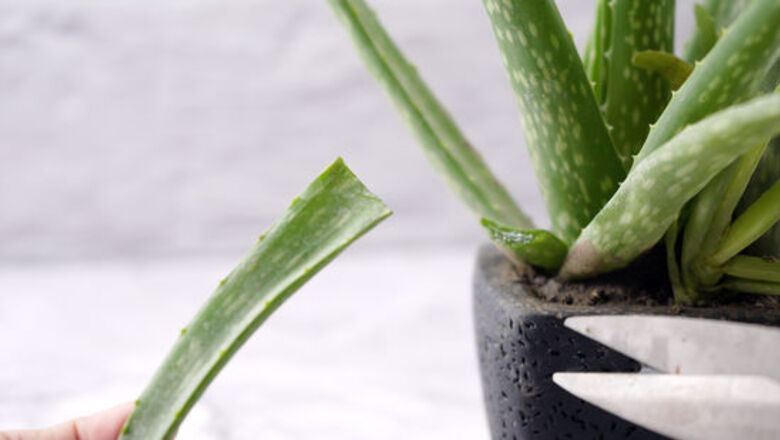
views
- Cut off a green, firm leaf toward the base of the aloe plant, then place it in a container for 10 minutes to let the yellow latex drain.
- Use a vegetable peeler or a sharp knife to remove first the spines of the leaf, then the broad, flat side of the skin.
- Use a spoon to scoop out the transparent aloe gel, then use a blender to mix the aloe into a smooth consistency.
- Store your aloe in a sterilized jar, freeze it in ice cube trays, or add vitamin C or honey to help preserve it over a longer period of time.
Harvesting Aloe
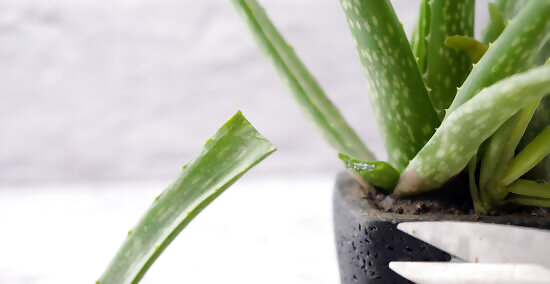
Slice off an outer leaf of a fresh aloe plant. The outer leaves are more likely to be mature and contain plenty of fresh, healthy gel. Select leaves around the base of the plant, with healthy, green, rigid stalks growing close to the dirt. Use a sharp knife or clean pair of scissors to make a neat cut as near to the base of the leaf as you can. Since Aloe vera gel is perishable, it's best not to make a huge batch at once, unless you plan to give some away. Cut off just 3-4 leaves in order to make 0.5–0.75 c (0.12–0.18 L) of gel. If your plant is young, be especially careful not to cut off too much at once. Cutting off all of the outer leaves could damage the plant.
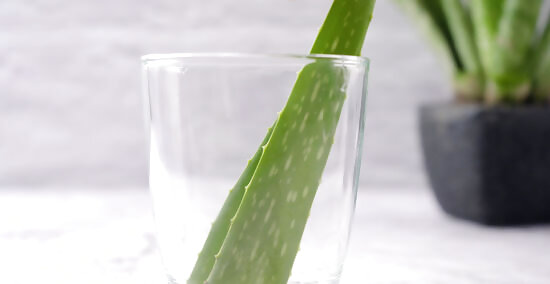
Rinse the leaf under cold water and cut away any yellow gel. Check the bottom of the leaf where you made the cut and trim away any portions that display a yellow or discolored discharge (in other words, any substance that isn’t the transparent aloe gel). This discharge contains latex, which may cause allergic reactions in some people. Additionally, place the leaf cut-side down into a container to allow any excess yellow resin drain for about 10 minutes, or until it stops dripping.
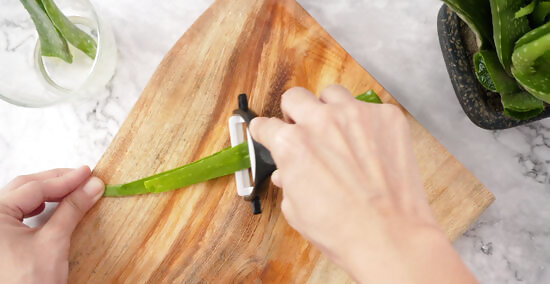
Peel the leaves with a vegetable peeler or knife. Use a vegetable peeler to carefully peel away the green skin of the leaves. Be sure to remove the thorns and cut through the inner white layer to the gel underneath. Peel off all of the skin on one side of each leaf, leaving a canoe-shaped half filled with gel. If you’re using a knife rather than a vegetable peeler, first cut away the thorny edges, then slice off the flat portion of the leaf’s skin, leaving the other side intact. If you have large leaves, cut them into smaller pieces before peeling to help manage their size as you work. Discard the skin as you go so it won't get mixed in with your gel.
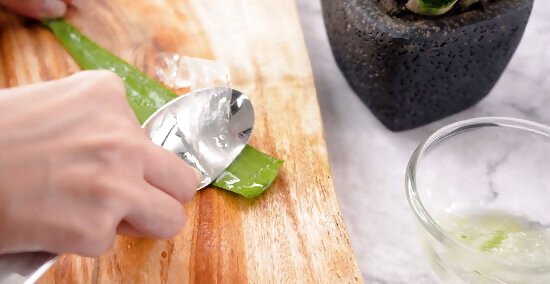
Scoop the gel out with a spoon or knife. The clear, soft gel is easy to scrape away from the skin. Use one hand to hold the leaf in place, and use the other to scoop it all out into a clean bowl until there's no more gel remaining in the leaf.
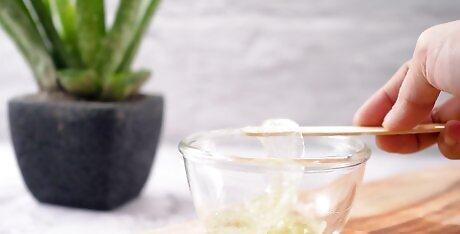
Mix the aloe gel in a blender. Freshly harvested aloe often has clumps or is even congealed into a strip, which makes it difficult to apply. To give your aloe a smoother consistency, place it in a blender and gradually pulse it on a low setting until it’s smooth and easily poured. Go ahead and add those white fleshy parts to the mixture, as well. They also contain aloe’s beneficial compounds, and can be used in the same ways once blended.
Storing Aloe Gel
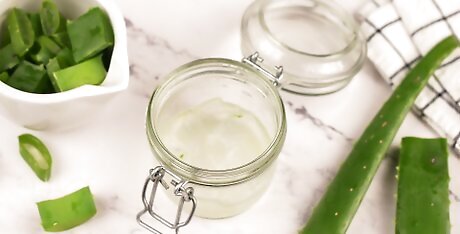
Freeze the gel in an ice cube tray. Pour your blended aloe gel into an ice cube tray, then place it in the freezer. Freezing aloe this way will keep it for up to 2 weeks. Anytime you need aloe, simply pop out a cube and rub it on your skin, or place it in a small dish to thaw for about an hour before applying it as a lotion.
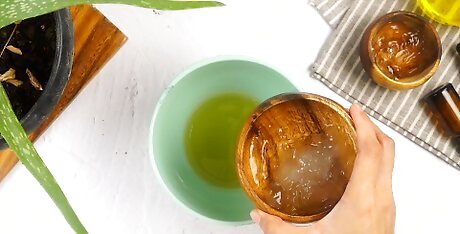
Mix your aloe with honey or vitamin C to preserve it. In a blender or a mixing bowl, simply mix an equal portion of honey into your aloe until the 2 are completely combined, then keep it in the refrigerator when you’re not using it. Honey is a perfect aloe preservative—it has an incredibly long shelf life, and is compatible with most of the things you use aloe for. Store aloe this way for up to 1 year. In addition, mix the gel with a natural preservative, like 500mg powdered vitamin C or 400 IU vitamin E for every 1/4 cup of gel you have. This preservation method will keep the gel for up to 90 days.
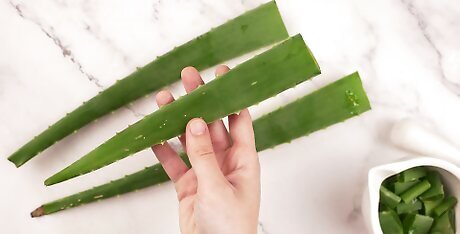
Store whole aloe leaves in the fridge for 4-5 days. If you harvested too many leaves, or simply won’t be using them on the same day, place your leaves in a plastic bag and store them in the fridge. Because the untreated leaves don’t have any added preservatives, they’ll only last a few days before they begin to wither. To make them last longer, place them in the freezer and store them there for 6-8 months.
Using Aloe Gel
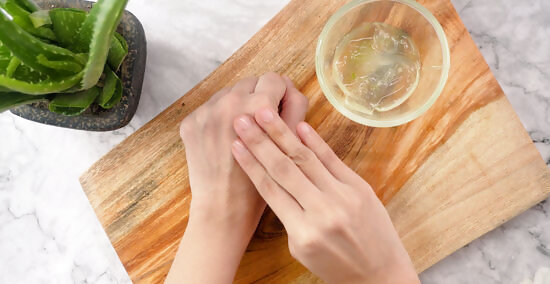
Rub aloe on sunburns to relieve pain. Aloe gel contains compounds that help the skin stop itching and soothe irritation. Rub a generous dab of aloe on a sunburn or other topical burn and let it absorb into your skin. Reapply it as long as your discomfort persists.
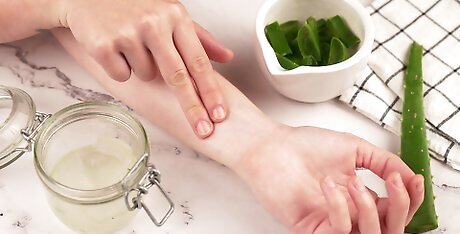
Apply aloe to minor cuts to promote healing. The same compounds in aloe that soothe irritation also help the body’s immune system and healing processes. Apply a small amount to shallow cuts or scrapes to relieve pain and help your skin recover. In addition, blend 0.5 cups (120 mL) aloe with 0.25 c (59 mL) melted coconut oil to make a healing, moisturizing massage lotion.
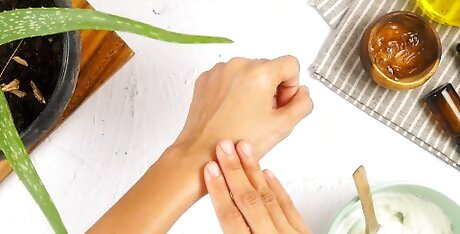
Use aloe as a moisturizer. Aloe gel has been used as a moisturizer and beauty product by the likes of Cleopatra herself. Rub about a quarter-sized amount between your hands, then apply it to your face, or any dry or irritated patch of skin, and reapply as often as needed.
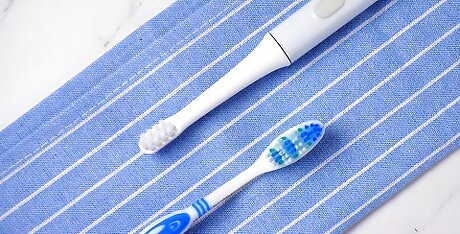
Use aloe gel as toothpaste. Just add a dab of aloe to a wet toothbrush, the same as you would your regular toothpaste, and get brushing! In some studies, aloe was more effective at controlling bacteria than commercial toothpastes. As an added plus, it’s easier on your teeth, since it doesn’t have any abrasive particles like many toothpaste products. Be careful not to ingest the aloe when using it as a toothpaste, as aloe can cause dehydration if consumed orally.



















Comments
0 comment